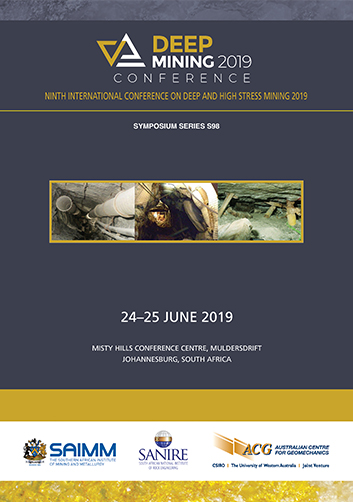Self-similarity in rock fracturing and the behaviour of large-scale faults in the mining environment

|
Authors: Morton, E; Villaescusa, E; Thompson, A |
DOI https://doi.org/10.36487/ACG_rep/1952_31_Morton
Cite As:
Morton, E, Villaescusa, E & Thompson, A 2019, 'Self-similarity in rock fracturing and the behaviour of large-scale faults in the mining environment', in W Joughin (ed.), Deep Mining 2019: Proceedings of the Ninth International Conference on Deep and High Stress Mining, The Southern African Institute of Mining and Metallurgy, Johannesburg, pp. 413-425, https://doi.org/10.36487/ACG_rep/1952_31_Morton
Abstract:
Seismicity and earthquakes are the consequences of rock mass fracturing. Laboratory testing has been used to simulate rock fracturing mechanisms since the 1960s, including by Mogi (1962), Scholz ( 1968), Hardy ( 1972), Hirata, Sato and Iko (1987), Main and Meredith (1989) and Lei et al (1992). These investigations suggest that rock fracturing has similar characteristics on all scales. They also reveal that seismic data contains precursory information that can suggest impending failure. Each of these researchers has used their analysis techniques to investigate large-scale earthquake behaviour; however only limited investigations of mining seismicity have been undertaken to-date. Morton (2019) has investigated almost 700 failures in the mining environment that are specifically related to large-scale faults. The aim of the analysis was to determine if fracturing data patterns recognised in small scale laboratory samples could be recognised in real-life mining data and if so, could be used to identify failure within the mining environment. Various analysis methods were presented. New techniques were developed to select seismic events specific to selected large-scale structures within the mining environment. This enabled the analysis of the behaviour of these individual structures. Analysis was conducted on temporal variations in event rate, spatial correlation length and b-value, magnitude and energy. This paper provides a summary of some of the results determined with the research. Analysis of event rate, magnitude and spatial correlation length are provided within this paper. The analysis method and the trends in the each of these parameters will be presented.
References:
Aki, K. (1965). Maximum likelihood estimate of b in the formula logN=a-bM and its confidence limits. Bulletin of earthquake research, University Tokyo, 43, pp 237-239.
Hardy, H.R. (1972). Application of acoustic emission techniques to rock mechanics research. In (ed.), Acoustic Emission. American society for testing and materials, pp 41-83.
Hirata, T., Satoh, T and Ito, K. (1987). Fractal structure of spatial distribution of micro fracturing in rock. Geophysical Journal of the Royal Astronomical Society, 90, pp369-374.
Lei, X. (2003). How do asperities fracture? An experimental study of unbroken asperities. Earth and planetary science letters, 213, pp347-359.
Lei, X., Kusunose, K, Rao, M, Nishizawa, O and Satoh, T. (2000). Quasi-static growth and cracking in homogeneous brittle rock under triaxial compression using acoustic emissions monitoring. Journal of Geophysical Research, 105, pp6127-6139.
Lei, X., Nishizawa, O, Kusunose, K and Satoh, T. (1992). Fractal structure of the hypocentre distributions and focal mechanism solutions of acoustic emission in two granites of different grain sizes. Journal of Physics of the Earth, 40, pp617-634.
Lockner, D., Byerlee, J, Kuksenko, V, Ponomarev, A and Sidorin, A. (1991). Quasi-static fault growth and shear fracture energy in granite. Nature, 350, pp39-42.
Main, I. and Meredith, P. (1989). Classification of earthquake precursors from a fracture mechanics model. Tectonophysics, 167, pp273-283.
Main, I., Meredith, P and Jones, C. (1989). A reinterpretation of the precursory seismic b-value anomaly from fracture mechanics. Geophysical Journal, 96, pp131-138.
Meredith, P. and Atkinson, B. (1983). Stress corrosion and acoustic emission during tension crack propagation in Whin Sill dolerite and other basic rocks. Geophysical Journal of the Royal Astronomical Society, 75, pp1-21.
Meredith, P., Main, I and Jones, C. (1990). Temporal variations in seismicity during quasi-static and dynamic rock failure. Tectonophysics, 175, pp249-268.
Mogi, K. (1962). Study of elastic shocks caused by the fracture of heterogeneous materials and its relations to earthquake phenomena. Bulletin of earthquake research institute, 40, pp125-173.
Mogi, K. (1968). Source locations of elastic shocks in the fracturing process in rocks (1). Bulletin of the Earthquake Institute, 46, pp1103-1125.
Morton, E. (2019). Seismic response of large-scale structures. PhD Thesis, Curtin University (in print).
Scholz, C. (1968). Experimental study of the fracturing process in brittle rock. Journal of geophysical research, 73, pp1447-1454.
Scholz, C., Sykes L. and Aggarwal, Y. (1973). Earthquake prediction: A physical basis. Science, 181, pp803-810.
Villaescusa, E., Lei, X, Nishizawa, O and Funatsu, T. (2009). Laboratory testing of brittle intact rock - Implications for in situ measurements and rock mass failure. In Knights P and Lever P (ed.), Proceedings of the 2009 Australian mining technology conference, AusIMM, Brisbane, pp 226-239.
© Copyright 2024, Australian Centre for Geomechanics (ACG), The University of Western Australia. All rights reserved.
View copyright/legal information
Please direct any queries or error reports to repository-acg@uwa.edu.au
View copyright/legal information
Please direct any queries or error reports to repository-acg@uwa.edu.au